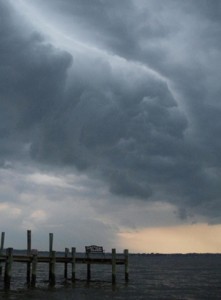by Kristen Minogue
Let’s face it, the East Coast has had an incredibly bizarre year. In 2011 so far, we’ve seen the coldest January on record, the hottest month on record (July), a hurricane, a tropical storm and an earthquake (we’re not even going to touch the last one – we’ll leave that to our colleagues at Natural History). And to top it off, August and September drenched us with uncharacteristically high rainfall. While SERC tends to focus on the long-term picture rather than brief snapshots, this year has prompted more than a few raised eyebrows among our scientists. What does it mean for the environment? What does it mean for Chesapeake Bay? And can any of it be linked to climate change?
Most of the head-turning data won’t be analyzed until winter, but SERC director Tuck Hines has a few answers, summarized below:
Climate Change – Much of the strange weather fits with global climate change predictions for the Bay: earlier springs, hotter summers, higher rainfall, fiercer storms and more extreme weather events in general. The cooler, wetter spring also washed more nutrients from crop planting into the Bay, fueling large algal blooms that clouded the water.
Lower salinity – More freshwater pouring into the Bay will naturally drive down its saltiness, and the Bay had more than its fair share this year. Tropical Storm Lee triggered the third largest flow on record at Conowingo Dam, where the Susquehanna River flows into the Chesapeake (almost 80 times higher than average – 778,000 cubic feet per second versus 10,000). Overall effect: Salinity in the Rhode River dropped to 3 parts per thousand in September, where it normally would have been 13. Which bring us to…
Snakehead invasion – Lower salinity breaks down one of the major barriers holding back certain invasive species. One of the more troubling ones – the northern snakehead – made a surprise appearance in the Rhode River this July. Snakeheads are famous for their ability to breathe out of water up to four days if moist and to eat just about anything up to a third their size. When they established themselves in the Potomac in 2004, scientists thought the saltier waters of the Bay would be enough to confine them to that single river. Now they suspect high rainfalls this year gave them a freshwater channel to cross the Bay and spread to other streams. But on a brighter note, less salty water also hinders the spread of stinging jellyfish.
Death of a dead zone – That massive storms occurred in late summer and autumn had at least one positive effect: an early demise to the Bay’s dead zone. Dead zones emerge when oxygen levels in the water drop so low it’s nearly impossible for organisms to survive. They generally occur in the hot summer months, when warmer waters hold less oxygen and algae on the surface suck up even more as they decay. Strong, windy cold fronts in later months stir up the water, bringing oxygen back to the starved areas. This year, thanks to earlier storms, the annual “fall turnover” washed away the dead zone sooner than usual. Which is good, because this summer the dead zone grew to more than 83 miles long.
Wood and other debris – There’s plenty of trash that floods into the Bay with all the stormwater runoff – glass, plastic and Styrofoam, to name a few. But some of the flotsam is wood. Woody debris provides critical habitat for young fish and young crabs, which depend on the structures for refuge while molting.
Fast recovery? Not all places are equally able to deal with weather extremes. In ecosystems like the Florida lagoons, which tend to trap water and its pollutants, recovery can take a year or more. Fortunately, Chesapeake Bay was once a river valley (now drowned). This gives it a terrain that allows storm water to pass through quickly, speeding recovery from chaotic years like this one.



What we should be really concerned of is why there are so strange temperatures lately and can we control this process… Because I believe that this is a sequence of human activity and we must think of prevention before its too late!
Dorothy: You are right. It is too late but this sequence will take about 100 years so dont worry.
Best
Peter